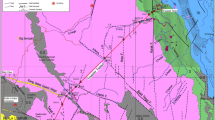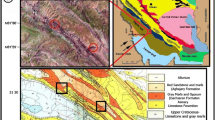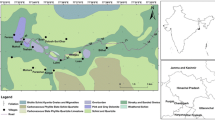Abstract
The present paper has developed a new multivariate linear regression and adaptive neuro-fuzzy inference processing to predict UCS for weathered granite grade III based on simple input data from point load index, Schmidt rebound hardness, and P wave velocity. Data from 85 rock core samples of this granite type have been selected. By using multivariate regression analysis, three models with two independent variables and one model with three independent variables have been developed. Furthermore, another model has been obtained by using a neuro-fuzzy logic analysis. The root means square error, RMSE, coefficient of determination, R2, and the mean absolute percentage error, MAPE, were used as the evaluation criteria of the accuracy of the models. The results have indicated that the regression-based and neuro-fuzzy models are effective, but the accuracy of the neuro-fuzzy model is in good agreement with the realistic data from the direct test.











Similar content being viewed by others
References
ASTM D2938–95 (2002) Standard test method for unconfined compressive strength of intact rock core specimens (Withdrawn 2005). ASTM International, West Conshohocken, PA, 1995
Aufmuth RE (1974) A systematic determination of engineering criteria for rock. Bull Int Assoc Eng Geol 11:235–245
Basu A, Kamran M (2010) Point load test on schistose rocks and its applicability in predicting uniaxial compressive strength, 823–828 p
Baykasoğlu A, Güllü H, Çanakçı H, Özbakır L (2008) Prediction of compressive and tensile strength of limestone via genetic programming. Expert Syst Appl 35(1):111–123
Bieniawski ZT (1989) Engineering rock mass classifications: a complete manual for engineers and geologists in mining, civil, and petroleum engineering. John Wiley & Sons, Hoboken, NJ
Bieniawski ZT, Bernede MJ (1979) Suggested methods for determining the uniaxial compressive strength and deformability of rock materials: part 1. Suggested method for determining deformability of rock materials in uniaxial compression. Int J Rock Mech Min Sci Geomech Abstr 16(2):138–140
Çelik S (2019) Prediction of uniaxial compressive strength of carbonate rocks from nondestructive tests using multivariate regression and LS-SVM methods. Arab J Geosci 12:193
Chang C, Zoback MD, Khaksar A (2006) Empirical relations between rock strength and physical properties in sedimentary rocks. J Pet Sci Eng 51(3):223–237
Dearman WR, Baynes FJ, Irfan TY (1978) Engineering grading of weathered granite. Eng Geol 12:345–374
Dehghan S, Sattari G, Chehreh Chelgani S, Aliabadi MA (2010) Prediction of uniaxial compressive strength and modulus of elasticity for Travertine samples using regression and artificial neural networks. Min Sci Technol (China) 20(1):41–46
Diamantis K, Gartzos E, Migiros G (2009) Study on uniaxial compressive strength, point load strength index, dynamic and physical properties of serpentinites from Central Greece: Test results and empirical relations. Eng Geol 108(3):199–207
Ferentinou M, Fakir M (2017) An ANN approach for the prediction of uniaxial compressive strength, of some sedimentary and igneous rocks in eastern KwaZulu-Natal. Procedia Eng 191:1117–1125
George D, Mallery P (2010) SPSS for windows step by step: a simple guide and reference 18.0 update (11th ed.). Prentice Hall Press, Upper Saddle River, NJ
Gorsuch RL (2013) Factor analysis (2nd ed.). Taylor and Francis, Oxfordshire, UK
Gupta AS, Seshagiri Rao K (2000) Weathering effects on the strength and deformational behaviour of crystalline rocks under uniaxial compression state. Eng Geol 56(3):257–274
Guttman L (1954) Some necessary conditions for common-factor analysis. Psychometrika 19(2):149–161
Hajihassani M, Marto A, Khezri N, Kalatehjari R (2015) Indirect measure of thermal conductivity of rocks through adaptive neuro-fuzzy inference system and multivariate regression analysis. Measurement 67:71–77
Heidari M, Khanlari GR, Torabi Kaveh M, Kargarian S (2012) Predicting the uniaxial compressive and tensile strengths of gypsum rock by point load testing. J Rock Mech Rock Eng 45(2):265–273
Jahed Armaghani D, Tonnizam Mohamad E, Momeni E, Narayanasamy MS, Mohd Amin M (2015) An adaptive neuro-fuzzy inference system for predicting unconfined compressive strength and Young’s modulus: a study on Main Range granite. Bull Eng Geol Environ 74(4):1301–1319
Jalali SH, Heidari M, Zarrinshoja M, Mohseni N (2019) Predicting of uniaxial compressive strength of some igneous and metamorphic rocks by block punch index and cylindrical punch index tests. Int J Rock Mech Min Sci 119:72–80
Jang JR (1993) ANFIS: adaptive-network-based fuzzy inference system. IEEE Trans Syst Man Cybern 23(3):665–685
Jang J-SR, Sun C-T, Mizutani E (1997) Neuro-fuzzy and soft computing: a computational approach to learning and machine intelligence. Prentice Hall, Upper Saddle River, NJ
Kahraman S (2001) Evaluation of simple methods for assessing the uniaxial compressive strength of rock. Int J Rock Mech Min Sci 38(7):981–994
Kahraman S (2014) The determination of uniaxial compressive strength from point load strength for pyroclastic rocks. Eng Geol 170:33–42
Kahraman S, Gunaydin O (2009) The effect of rock classes on the relation between uniaxial compressive strength and point load index. Bull Eng Geol Environ 68(3):345–353
Kaiser HF (1958) The varimax criterion for analytic rotation in factor analysis. Psychometrika 23(3):187–200
Kaiser HF (1961) A note on Guttman’s lower bound for the number of common factors. Br J Stat Psychol 14(1):1–2
Karaman K, Kesimal A, Ersoy H (2015) A comparative assessment of indirect methods for estimating the uniaxial compressive and tensile strength of rocks. Arab J Geosci 8(4):2393–2403
Kartalopoulos SV (1996) Understanding neural networks and fuzzy logic: basic concepts and applications. John Wiley & Sons, IEEE Neural Networks Council, New York
Katz O, Reches Z, Roegiers JC (2000) Evaluation of mechanical rock properties using a Schmidt Hammer. Int J Rock Mech Min Sci 37(4):723–728
Kohno M, Maeda H (2012) Relationship between point load strength index and uniaxial compressive strength of hydrothermally altered soft rocks. Int J Rock Mech Min Sci 50:147–157
Looney CG (1997) Pattern recognition using neural networks: theory and algorithms for engineers and scientists. Oxford University Press, Oxford, England
Lumb P (1962) The properties of decomposed granite. Géotechnique 12(3):226–243
Madhubabu N, Singh PK, Kainthola A, Mahanta B, Tripathy A, Singh TN (2016) Prediction of compressive strength and elastic modulus of carbonate rocks. Measurement 88:202–213
Minaeian B, Ahangari K (2013) Estimation of uniaxial compressive strength based on P-wave and Schmidt hammer rebound using statistical method. Arab J Geosci 6(6):1925–1931
Mishra DA, Basu A (2012) Use of the block punch test to predict the compressive and tensile strengths of rocks. Int J Rock Mech Min Sci 51:119–127
Mohammadi M, Tavakoli H (2015) A study of the behaviour of brittle rocks subjected to confined stress based on the Mohr–Coulomb failure criterion. Geomech Geoeng 10(1):57–67
Mohammadi K, Shamshirband S, Kamsin A, Yusof RJR (2016) Retracted: application of adaptive neuro-fuzzy technique to determine the most relevant variables for daily soil temperature prediction at different depths. Catena 145:204–213
Moradian ZA, Behnia M (2009) Predicting the uniaxial compressive strength and static young’s modulus of intact sedimentary rocks using the ultrasonic test. Int J Geomech 9(1):14–19
Moye D (1955) Engineering geology for the Snowy Mountains Scheme. J Inst Eng Aust 27(10):287–298
Nelson, MMC, Illingworth WT (1991) A practical guide to neural nets. Addison-Wesley, Boston, MA
Ng I-T, Yuen K-V, Lau C-H (2015) Predictive model for uniaxial compressive strength for grade III granitic rocks from Macao. Eng Geol 199:28–37
Rezaei M, Davoodi PK, Najmoddin I (2019) Studying the correlation of rock properties with P-wave velocity index in dry and saturated conditions. J Appl Geophys 169:49–57
Roghanchi P, Kallu RR (2014) Block punch index (BPI) test—a new consideration on validity and correlations for basalt and rhyolite rock types. J Min Sci 50(3):475–483
Romo MP, Garcia SR (2003) Neurofuzzy mapping of CPT values into soil dynamic properties. Soil Dyn Earthq Eng 23(6):473–482
Salehin S (2017) Investigation into engineering parameters of marls from Seydoon dam in Iran. J Rock Mech Geotech Eng 9(5):912–923
Sarkar K, Tiwary A, Singh TN (2010) Estimation of strength parameters of rock using artificial neural networks. Bull Eng Geol Environ 69(4):599–606
Shapiro SS, Wilk MB (1965) An analysis of variance test for normality (complete samples). Biometrika 52(3–4):591–611
Sharma PK, Singh TN (2008) A correlation between P-wave velocity, impact strength index, slake durability index and uniaxial compressive strength. Bull Eng Geol Environ 67(1):17–22
Singh TN, Kainthola A, Venkatesh A (2012) Correlation between point load index and uniaxial compressive strength for different rock types. J Rock Mech Rock Eng 45(2):259–264
Sonmez H, Tunusluoglu C (2008) New considerations on the use of block punch index for predicting the uniaxial compressive strength of rock material. Int J Rock Mech Min Sci 45(6):1007–1014
Sonmez H, Gokceoglu C, Nefeslioglu HA, Kayabasi A (2006) Estimation of rock modulus: for intact rocks with an artificial neural network and for rock masses with a new empirical equation. Int J Rock Mech Min Sci 43(2):224–235
Swingler K (1996) Applying neural networks: a practical guide. Academic Press, Cambridge
Tsiambaos G, Sabatakakis N (2004) Considerations on strength of intact sedimentary rocks. Eng Geol 72(3):261–273
Tuğrul A, Zarif IH (1999) Correlation of mineralogical and textural characteristics with engineering properties of selected granitic rocks from Turkey. Eng Geol 51(4):303–317
Ulusay R, Gokceoglu C, Sulukcu S (2001) Draft ISRM suggested method for determining block punch strength index (BPI). Int J Rock Mech Min Sci 38(8):1113–1119
Wang L, Wu C, Gu X, Liu H, Mei G, Zhang W (2020) Probabilistic stability analysis of earth dam slope under transient seepage using multivariate adaptive regression splines. Bull Eng Geol Environ 79(6):2763–2775
Wengang Z, Liang H, Zixu Z, Yanmei Z (2020) Digitalization of mechanical and physical properties of Singapore Bukit Timah granite rocks based on borehole data from four sites. https://doi.org/10.1016/j.undsp.2020.02.003
Yagiz S (2011) P-wave velocity test for assessment of geotechnical properties of some rock materials. Bull Mater Sci 34(4):947
Yasar E, Erdogan Y (2004) Correlating sound velocity with the density, compressive strength and Young’s modulus of carbonate rocks. Int J Rock Mech Min Sci 41(5):871–875
Yeomans KA, Golder PA (1982) The Guttman-Kaiser criterion as a predictor of the number of common factors. Statistician 31(3):221
Yesiloglu-Gultekin N, Gokceoglu C, Sezer EA (2013) Prediction of uniaxial compressive strength of granitic rocks by various nonlinear tools and comparison of their performances. Int J Rock Mech Min Sci 62:113–122
Zahmatkesh I, Soleimani B, Kadkhodaie A, Golalzadeh A, Abdollahi A-M (2017) Estimation of DSI log parameters from conventional well log data using a hybrid particle swarm optimization–adaptive neuro-fuzzy inference system. J Pet Sci Eng 157:842–859
Zhang W, Zhang Y, Goh ATC (2017) Multivariate adaptive regression splines for inverse analysis of soil and wall properties in braced excavation. Tunn Undergr Space Technol 64:24–33
Zhang W, Wu C, Zhong H, Li Y, Wang L (2020a) Prediction of undrained shear strength using extreme gradient boosting and random forest based on Bayesian optimization. Geosci Front 12(1):469–477
Zhang W, Zhang R, Wu C, Goh ATC, Lacasse S, Liu Z, Liu H (2020b) State-of-the-art review of soft computing applications in underground excavations. Geosci Front 11(4):1095–1106
Acknowledgments
The authors would like to thank Dr. H. Shahriari for their critical reviews of this manuscript.
Author information
Authors and Affiliations
Corresponding author
Appendix
Appendix
Rights and permissions
About this article
Cite this article
Moosavi, S.A., Mohammadi, M. Development of a new empirical model and adaptive neuro-fuzzy inference systems in predicting unconfined compressive strength of weathered granite grade III. Bull Eng Geol Environ 80, 2399–2413 (2021). https://doi.org/10.1007/s10064-020-02071-8
Received:
Accepted:
Published:
Issue Date:
DOI: https://doi.org/10.1007/s10064-020-02071-8




